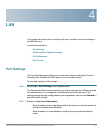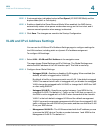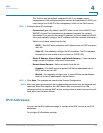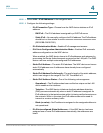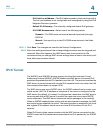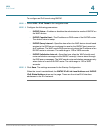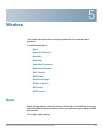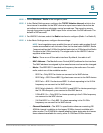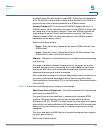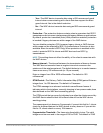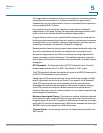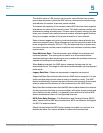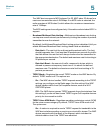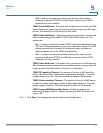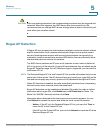
Wireless
Radio
Cisco Small Business WAP551 and WAP561 Wireless-N Access Point 59
5
STEP 1 Select Wireless > Radio in the navigation pane.
STEP 2 In the Global Settings area, configure the TSPEC Violation Interval, which is the
time interval in seconds for the WAP device to report associated clients that do
not adhere to mandatory admission control procedures. The reporting occurs
through the system log and SNMP traps. Enter a time from 0 to 900 seconds. The
default is 300 seconds.
STEP 3 For WAP561 devices, select the Radio interface to configure (Radio 1 or Radio 2).
STEP 4 In the Basic Settings area, configure these settings:
NOTE Local regulations may prohibit the use of certain radio modes. Not all
modes are available in all countries. Also, for the dual-radio WAP561, Radio
1 supports either the 2.4 GHz (the default selection) or 5 GHz band, but Radio
2 supports the 5 GHz band only. The single radio on the WAP551 device
supports either band.
• Radio—Turns on or off the radio interface. By default, the radio is off.
• MAC Address—The Media Access Control (MAC) address for the interface.
The MAC address is assigned by the manufacturer and cannot be changed.
• Mode—The IEEE 802.11 standard and frequency the radio uses. For each
radio, select one of the available modes:
- 802.11a—Only 802.11a clients can connect to the WAP device.
- 802.11b/g—802.11b and 802.11g clients can connect to the WAP device.
- 802.11a/n—802.11a clients and 802.11n clients operating in the 5-GHz
frequency can connect to the WAP device.
- 802.11b/g/n (default)—802.11b, 802.11g, and 802.11n clients operating in
the 2.4-GHz frequency can connect to the WAP device.
- 5 GHz 802.11n—Only 802.11n clients operating in the 5-GHz frequency
can connect to the WAP device.
- 2.4 GHz 802.11n—Only 802.11n clients operating in the 2.4-GHz
frequency can connect to the WAP device.
• Channel Bandwidth—The 802.11n specification allows a coexisting 20/
40 MHz channel in addition to the legacy 20 MHz channel available with
other modes. The 20/40 MHz channel enables higher data rates but leaves
fewer channels available for use by other 2.4 GHz and 5 GHz devices.




